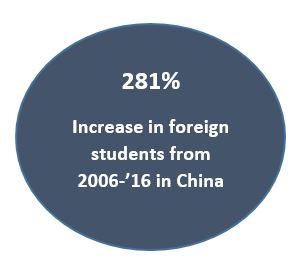The Indian government (GoI) seems to be going places when it comes to attracting foreign students to pursue their higher education in India. It is keen to sign a pact with 30 countries in Asia, Africa and Commonwealth of Independent States (CIS) for mutual recognition of academic programs and degrees like the one it recently undertook with France. This follows the Study in India initiative launched a month back which aims at providing end-to-end information of all Indian institutes and offer guidance to foreign students. The initiative aims to increase the current foreign student count from 45,000 to around 2 lakhs by the year 2023.
Lessons From China
 If the initiative is to be a success, then India will have to take a few necessary steps like China did in the 1990s.
If the initiative is to be a success, then India will have to take a few necessary steps like China did in the 1990s.
- India needs to make its institutions of higher education like the IITs, IIMs, etc. as desirable to the Indian academia abroad.
- It needs to invest in research by placing modern labs and other associated benefits in place.
- It also needs to offer fellowship to foreign students in order to make their education affordable and offer a comfortable stay in India for the long term.
 The Indian government has been slowly taking steps in this direction with 55% of foreign students being offered merit-based fee waivers at Indian institutions. However, there is still a large amount of work that needs to be done for improving the quality of living for foreign students on Indian campuses.
The Indian government has been slowly taking steps in this direction with 55% of foreign students being offered merit-based fee waivers at Indian institutions. However, there is still a large amount of work that needs to be done for improving the quality of living for foreign students on Indian campuses.
Long-term Benefits (Study In India)
If the Indian government is able to pull this off then it will unlock doors to a number of long-term benefits:
-
Increased visibility:
 It will lead to an increase in visibility for Indian institutions at the global level. Currently, there are 30 Indian universities in the Top 1000 as per the QS World University Rankings. According to the International Student Survey, the teaching quality and a sense of welcome are major factors in addition to ranking, while making a decision. Thus, India can bank upon all the three factors to become a hot spot for foreign students.
It will lead to an increase in visibility for Indian institutions at the global level. Currently, there are 30 Indian universities in the Top 1000 as per the QS World University Rankings. According to the International Student Survey, the teaching quality and a sense of welcome are major factors in addition to ranking, while making a decision. Thus, India can bank upon all the three factors to become a hot spot for foreign students.
-
GDP Contribution:
Become a significant contributor to the GDP of the country. Foreign students added around $ 37 bn. to the US economy in 2016-’17, $23.4 bn. to the UK economy and $24.7 bn to the Australian economy in 2017-‘18. India’s current contribution to GDP from foreign students is at a minuscule number but over the years it is bound to increase as it finds more takers from students abroad.
-
Increased collaboration:
 Areas like research, technology, and innovation would increase among member countries. As of now, India invests just 0.8% of its GDP on R&D whereas most of the developed economies spend approximately around 2% of their GDPs on R&D. However, India has been able to gain momentum in terms of its R&D with tech alliances with the UK, Russia, Israel, China, etc.
Areas like research, technology, and innovation would increase among member countries. As of now, India invests just 0.8% of its GDP on R&D whereas most of the developed economies spend approximately around 2% of their GDPs on R&D. However, India has been able to gain momentum in terms of its R&D with tech alliances with the UK, Russia, Israel, China, etc.
-
Balanced Student Mobility:
Encourage mobility of students from member countries to and fro from India. Currently, India has around 5.5 lakh students studying abroad and with better quality universities and foreign students taking up options in India, this figure will surely become more equal in nature.
Even though the Study in India initiative appears to be a novel idea to make India as one of the destinations on a foreign student’s radar, it still has a long way to go. If the Indian government aims to increase the number to 2 lakhs and beyond in the next 5 years, then it definitely needs to increase the quality of its educational offerings.
Share your views with us in comments below or email us at monika.bakshi@univariety.com





1 Comment
India needs to first think beyond the fixes structure od universities and think of logical entrance criteria of a course then only it can be successful else we will keep on having students moving out